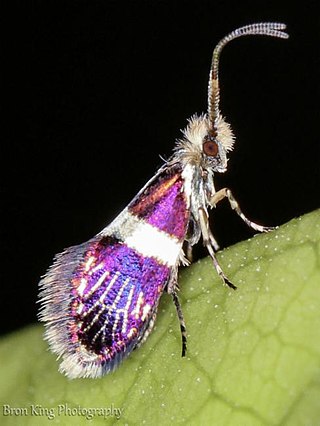
Mission Beach is a coastal town and locality in the Cassowary Coast Region, Queensland, Australia. In the 2021 census, the locality of Mission Beach had a population of 1,014 people.
Austromartyria porphyrodes is a moth of the family Micropterigidae. It is only known to be from the higher rainfall regions of the Atherton Tableland in northern Queensland.

Tasmantrix calliplaca is a moth of the Micropterigidae family. It is known from eastern Australia, in coastal rainforest from Finch Hatton Gorge, Eungella Range in Queensland to Elizabeth Beach in New South Wales.
Tasmantrix fragilis is a moth of the family Micropterigidae from eastern Australia. It is known only from a single locality in the Shoalhaven catchment in New South Wales.
Tasmantrix lunaris is a moth of the family Micropterigidae. It is known from eastern Australia, where it is known from two localities in the southern coastal forests of New South Wales.

Tasmantrix nigrocornis is a moth of the family Micropterigidae. It is known from eastern Australia, in coastal rainforests of southern New South Wales from Mount Keira to Mount Dromedary.
Tasmantrix phalaros is a moth of the family Micropterigidae. It is known from eastern Australia, in wet, upland eucalypt forests of northern New South Wales from Minyon Falls to Narara.
Tasmantrix tasmaniensis is a moth of the family Micropterigidae. It is known from in wet forests of western Tasmania.
Nannopterix choreutes is a moth of the family Micropterigidae. It is known from New Caledonia, from the Table Unio south to Rivière Bleue.
Agrionympha capensis is a species of moth belonging to the family Micropterigidae. It was described by Whalley in 1978. It is known from South Africa, where it is found in the Western and Eastern Cape districts.
Agrionympha vari is a species of moth belonging to the family Micropterigidae. It was described by Whalley in 1978. It is found in South Africa, where it is known only from the Mariepskop in the Mpumalanga Province.
Agrionympha pseliacma is a species of moth belonging to the family Micropterigidae. It was described by Edward Meyrick in 1921. It is found in South Africa, where it is known only from Karkloof Falls in KwaZulu-Natal.
Paramartyria anmashana is a species of moth belonging to the family Micropterigidae. It was described in 2000 and is only known from Taiwan. The type series was collected at an elevation of 2,200 m (7,200 ft) above sea level on Anmashan in Taichung.
Vietomartyria expeditionis is a species of moth belonging to the family Micropterigidae. It was described by Wolfram Mey in 1997. It is known from the mountainous areas of northern Vietnam.
Agrionympha fuscoapicella is a species of moth belonging to the family Micropterigidae. It was described by George W. Gibbs and Niels P. Kristensen in 2011. It is found in South Africa, where it is known only from Hogsback in the Eastern Cape.
Agrionympha jansella is a species of moth belonging to the family Micropterigidae. It was described by George W. Gibbs and Niels P. Kristensen in 2011. It is found in South Africa, where it is known only from Karkloof Falls in the Eastern Cape.
Agrionympha kroonella is a species of moth belonging to the family Micropterigidae. It was described by George W. Gibbs and Niels P. Kristensen in 2011. It is found in South Africa, where it is known only from the Drakensberg Ranges in the Mpumalanga Province.
Agrionympha pseudovari is a species of moth belonging to the family Micropterigidae. It was described by George W. Gibbs and Niels P. Kristensen in 2011. It is found in South Africa, where it is known only from the Western Cape.
Agrionympha sagittella is a species of moth belonging to the family Micropterigidae. It was described by George W. Gibbs and Niels P. Kristensen in 2011. It is found in South Africa, where it is known from the Hogsback and Ngadu Forests in the Eastern Cape.
Micropterix stuebneri is a species of moth belonging to the family Micropterigidae. It was described by Zeller, Werno and Kurz in 2013. It is only known from the Sierra Nevada in Spain.

